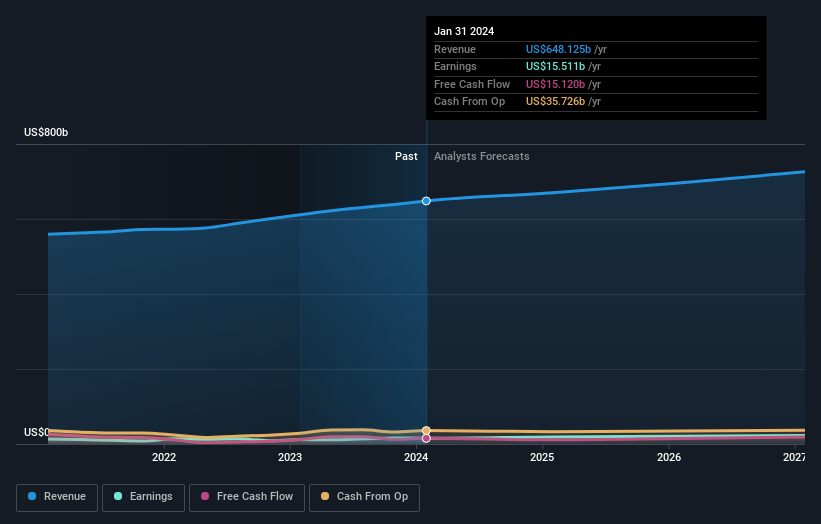Results: Walmart Inc. Beat Earnings Expectations And Analysts Now Have New Forecasts
Walmart Inc. (NYSE:WMT) last week reported its latest annual results, which makes it a good time for investors to dive in and see if the business is performing in line with expectations. Walmart reported US$648b in revenue, roughly in line with analyst forecasts, although statutory earnings per share (EPS) of US$1.91 beat expectations, being 5.6% higher than what the analysts expected. Following the result, the analysts have updated their earnings model, and it would be good to know whether they think there's been a strong change in the company's prospects, or if it's business as usual. So we collected the latest post-earnings statutory consensus estimates to see what could be in store for next year.
Check out our latest analysis for Walmart
Taking into account the latest results, the most recent consensus for Walmart from 31 analysts is for revenues of US$670.0b in 2025. If met, it would imply a credible 3.4% increase on its revenue over the past 12 months. Per-share earnings are expected to leap 21% to US$2.34. In the lead-up to this report, the analysts had been modelling revenues of US$668.9b and earnings per share (EPS) of US$2.34 in 2025. The consensus analysts don't seem to have seen anything in these results that would have changed their view on the business, given there's been no major change to their estimates.
It will come as no surprise then, to learn that the consensus price target is largely unchanged at US$65.35. Fixating on a single price target can be unwise though, since the consensus target is effectively the average of analyst price targets. As a result, some investors like to look at the range of estimates to see if there are any diverging opinions on the company's valuation. The most optimistic Walmart analyst has a price target of US$76.00 per share, while the most pessimistic values it at US$50.00. There are definitely some different views on the stock, but the range of estimates is not wide enough as to imply that the situation is unforecastable, in our view.
Taking a look at the bigger picture now, one of the ways we can understand these forecasts is to see how they compare to both past performance and industry growth estimates. We would highlight that Walmart's revenue growth is expected to slow, with the forecast 3.4% annualised growth rate until the end of 2025 being well below the historical 4.7% p.a. growth over the last five years. Compare this against other companies (with analyst forecasts) in the industry, which are in aggregate expected to see revenue growth of 4.5% annually. So it's pretty clear that, while revenue growth is expected to slow down, the wider industry is also expected to grow faster than Walmart.
The Bottom Line
The most important thing to take away is that there's been no major change in sentiment, with the analysts reconfirming that the business is performing in line with their previous earnings per share estimates. Fortunately, the analysts also reconfirmed their revenue estimates, suggesting that it's tracking in line with expectations. Although our data does suggest that Walmart's revenue is expected to perform worse than the wider industry. The consensus price target held steady at US$65.35, with the latest estimates not enough to have an impact on their price targets.
Keeping that in mind, we still think that the longer term trajectory of the business is much more important for investors to consider. We have forecasts for Walmart going out to 2027, and you can see them free on our platform here.
Before you take the next step you should know about the 1 warning sign for Walmart that we have uncovered.
Have feedback on this article? Concerned about the content? Get in touch with us directly. Alternatively, email editorial-team (at) simplywallst.com.
This article by Simply Wall St is general in nature. We provide commentary based on historical data and analyst forecasts only using an unbiased methodology and our articles are not intended to be financial advice. It does not constitute a recommendation to buy or sell any stock, and does not take account of your objectives, or your financial situation. We aim to bring you long-term focused analysis driven by fundamental data. Note that our analysis may not factor in the latest price-sensitive company announcements or qualitative material. Simply Wall St has no position in any stocks mentioned.

